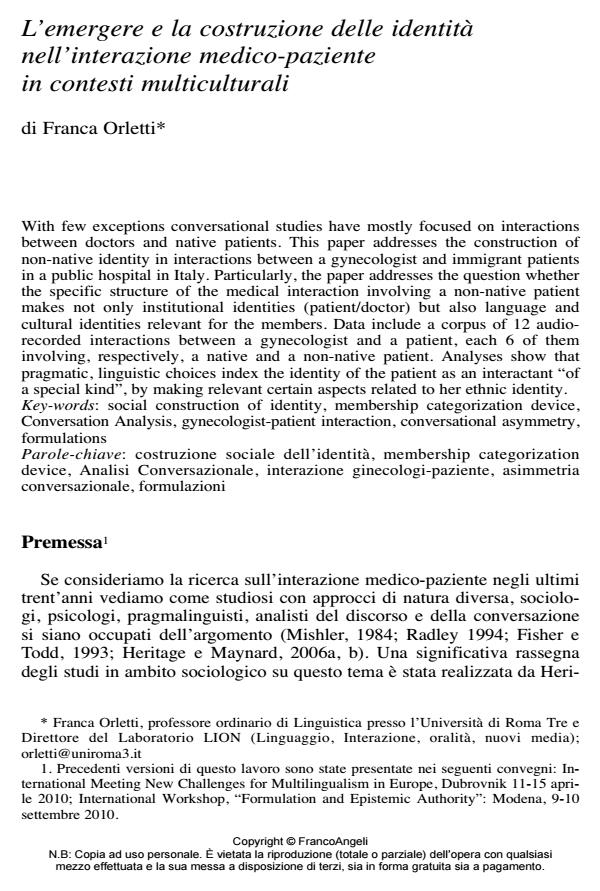L’emergere e la costruzione delle identità nell’interazione medico-paziente in contesti multiculturali
Journal title SALUTE E SOCIETÀ
Author/s Franca Orletti
Publishing Year 2013 Issue 2013/1
Language Italian Pages 15 P. 61-75 File size 119 KB
DOI 10.3280/SES2013-001006
DOI is like a bar code for intellectual property: to have more infomation
click here
Below, you can see the article first page
If you want to buy this article in PDF format, you can do it, following the instructions to buy download credits

FrancoAngeli is member of Publishers International Linking Association, Inc (PILA), a not-for-profit association which run the CrossRef service enabling links to and from online scholarly content.
With few exceptions conversational studies have mostly focused on interactions between doctors and native patients. This paper addresses the construction of non-native identity in interactions between a gynecologist and immigrant patients in a public hospital in Italy. Particularly, the paper addresses the question whether the specific structure of the medical interaction involving a non-native patient makes not only institutional identities (patient/doctor) but also language and cultural identities relevant for the members. Data include a corpus of 12 audiorecorded interactions between a gynecologist and a patient, each 6 of them involving, respectively, a native and a non-native patient. Analyses show that pragmatic, linguistic choices index the identity of the patient as an interactant "of a special kind", by making relevant certain aspects related to her ethnic identity.
Keywords: Social construction of identity, membership categorization device, Conversation Analysis, gynecologist-patient interaction, conversational asymmetry, formulations
- (Re)transmettre la souffrance émotionnelle : une analyse interactionnelle de consultations entre soignants, demandeurs d’asile et interprètes en France Vanessa Piccoli, in Langage et société /2019 pp.175
DOI: 10.3917/ls.167.0175 - The agency of language in institutional talk Letizia Caronia, Franca Orletti, in Language and Dialogue /2019 pp.1
DOI: 10.1075/ld.00029.orl - Chinese Interpreting Sabrina Ardizzoni, pp.335 (ISBN:978-3-031-66366-6)
- Interculturality in Institutions Marilena Fatigante, Cristina Zucchermaglio, Francesca Alby, pp.161 (ISBN:978-3-031-12625-3)
- ‘We will take care of you’: Identity categorisation markers in intercultural medical encounters Valentina Fantasia, Cristina Zucchermaglio, Marilena Fatigante, Francesca Alby, in Discourse Studies /2021 pp.451
DOI: 10.1177/14614456211009060
Franca Orletti, L’emergere e la costruzione delle identità nell’interazione medico-paziente in contesti multiculturali in "SALUTE E SOCIETÀ" 1/2013, pp 61-75, DOI: 10.3280/SES2013-001006